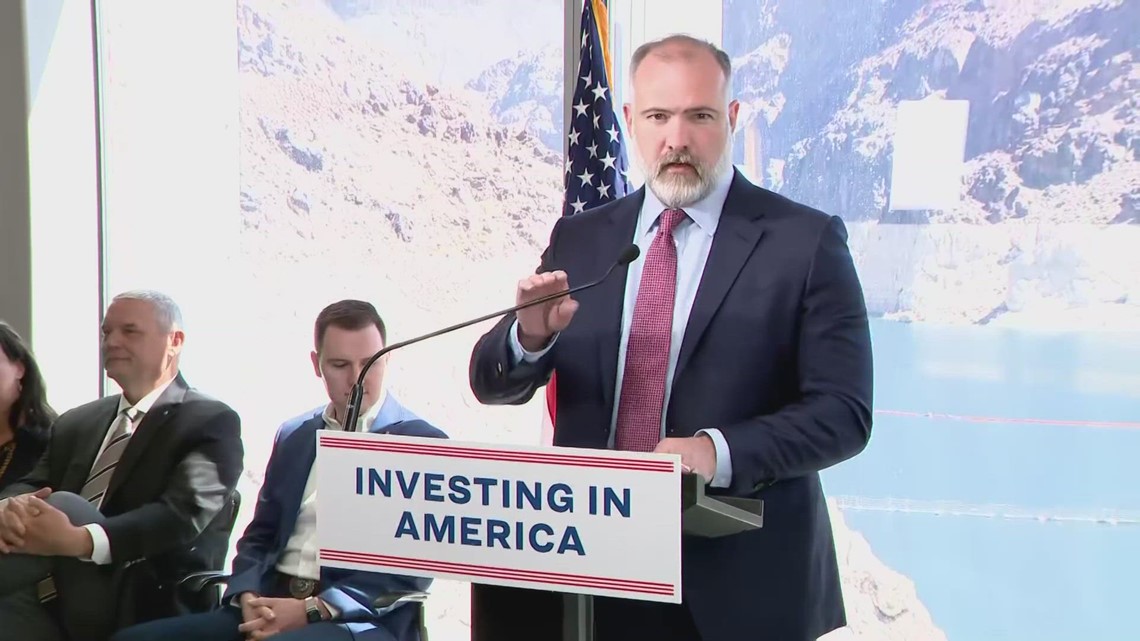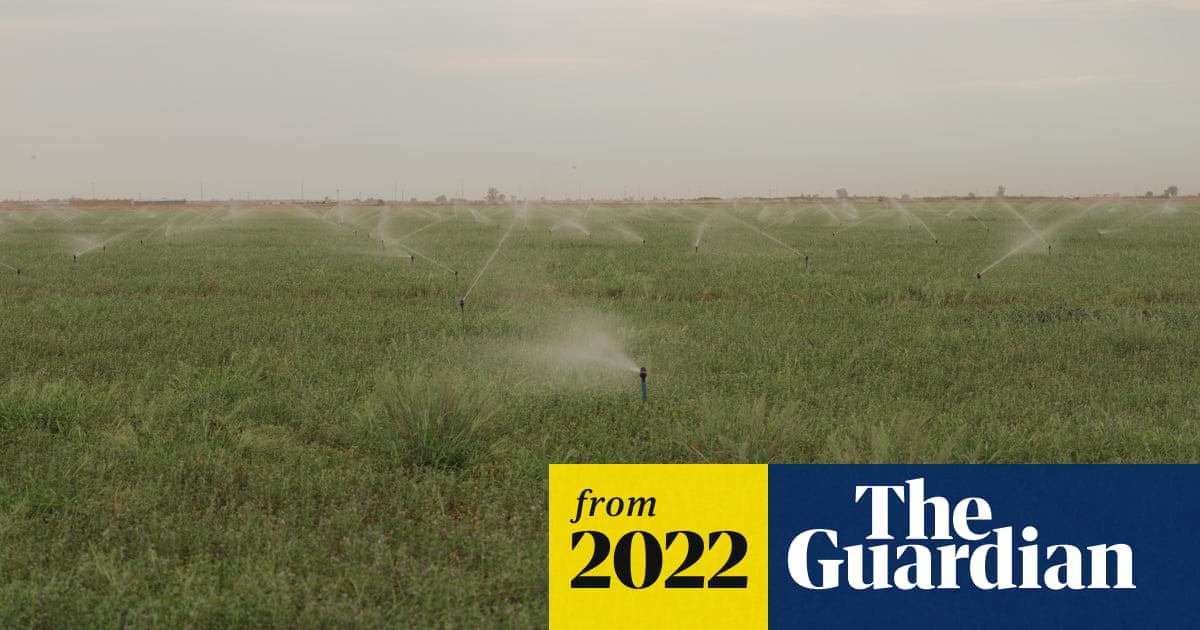Washington Post published what I thought is a good article today on issues surrounding Imperial Valley farmers. I am posting the text content for informative purposes, and not to make any particular conclusion/implication.
Water cuts could save the Colorado River. Farmers are in the crosshairs.
California’s Imperial Valley uses more water than several other states combined. Farmers want to avoid big cuts.
By Joshua Partlow
April 16, 2023 at 6:00 a.m. EDT
BRAWLEY, Calif. — Alex Jack has spared little expense in the quest to grow vegetables in the desert with less water.
It has cost him $2.5 million over the years to be on the cutting edge of efficiency, installing underground irrigation under alfalfa and lettuce beds, building aerated reservoirs
and a network of pipes and pumps to recycle runoff. But his 3,500-acre farm still guzzles more of the Colorado River each year than some midsize cities.
Now, as the Biden administration moves closer to imposing unprecedented cuts in how much water states can pull from the river, Jack and other commercial farmers in the
sun-scorched flatlands of the Imperial Valley are in the crosshairs of those reductions.
The Imperial Valley — a wedge of desert farmland in Southern California on the Mexican border — uses more of the Colorado River than the states of Utah, Wyoming, Nevada and New Mexico combined. To its critics outside California, it is a logical place to cut: The roughly 400 farms served by the Imperial Irrigation District consume the single largest share of a river that is needed by 40 million people. Some of their major crops, such as alfalfa, require lavish amounts of water and are sold for animal feed, including outside the United States.
And yet, these farmers also have some of the oldest legal rights to that water, dating back more than a century to a time before the creation of the Bureau of Reclamation, the federal agency that now oversees how the river is divvied up. And their fields drive a $4 billion industry that employs tens of thousands of people and puts vegetables in
supermarkets across the country during the winter.
That dynamic has put farmers such as Jack in a powerful, yet precarious, position. There is an ongoing dispute between California and other states of the Colorado River basin about who must bear the brunt of any future reductions. The Interior Department proposed three options for cuts this week, including one that strictly follows water rights, giving priority to the Imperial Valley’s farmers — and potentially letting the portion of the river that goes to Los Angeles and Phoenix draw down to virtually nothing.
Many river experts consider that politically untenable.
“Is the [Imperial Irrigation District] really going to be allowed to grow alfalfa hay and export it while 10 million people in Los Angeles go without?” said Ted Cooke, who
recently retired as the general manager of the Central Arizona Project, which distributes the Colorado River in that state.
“Of course not.”
As the negotiations between the states continue in a bid to prevent the federal government from making unilateral cuts this summer, some farmers are seeking to buy new
land to secure rights to more water. Jack and other farmers have met with Reclamation commissioner Camille Calimlim Touton and wrestled with how much they should be
paid to voluntarily give up a portion of their supply.
The more than $4 billion Reclamation has to spend from the Inflation Reduction Act on drought resilience is attracting a lot of interest among California farmers. But the
Imperial Irrigation District has not yet reached an agreement with the federal government on compensation for cuts. Farmers here say the amounts they’ve heard discussed
do not seem enough to pay for more efficient irrigation practices that could save water long-term. The only option, they say, may be to leave ground fallow. That practice
ripples through the economy as workers lose jobs, suppliers lose business and produce prices rise.
“Fallowing destroys our ag economy,” said Alex Cardenas, president of the Imperial Irrigation District board of directors. “There are alternatives to fallowing. But there’s
significant investment that needs to be made.”
Jack and other farmers in the Imperial Valley say they are willing to negotiate fair compensation but are also ready to defend the lifeblood of their community.
“We have water rights. And we will stand on our water rights,” he added. “If you’re going to fight us, it’s like fighting a warthog. We’ll get in deep and watch our territory.”
Cities and farms face dire trade-offs
On Tuesday, the Biden administration released a 476-page environmental review of the Colorado River and how to handle the fact that the river and its major reservoirs are
drying up. The drought since 2000, the Bureau of Reclamation wrote, has been the driest 23-year period in more than a century, and led to a 20 percent decrease in the river’s natural flows.
Without action, or a meaningful change in those trends, “Colorado River reservoirs will continue to decline to critically low elevations, threatening essential water supplies
across seven states in the United States and two states in Mexico,” the document reads.
The Interior Department proposed two approaches to conserving water to keep major reservoirs of Lake Powell and Lake Mead from crashing. One favors those with senior
water rights, such as the Imperial Valley, and makes deep cuts in Arizona and Nevada; the other would cut the same percentage from all three states.
California has already offered to cut back on 400,000 acre-feet of water, with 250,000 of that coming from the Imperial Valley, about 10 percent of its annual usage. If
Interior chose its alternative for equal cuts across states, that could mean more than half a million acre feet of additional cuts for California next year. The Imperial Valley
would likely shoulder a large portion of that.
That alternative “might seem politically good-sounding, because it’s equal cuts for everyone,” JB Hamby, California’s Colorado River commissioner, said in an interview. “But
it’s not on solid legal foundation whatsoever, because it sidesteps the established law of the river.”
Hamby said the goal for California is still to reach an agreement among the other Colorado River states rather than choosing one of the federal alternatives. The bountiful
snowfall in the West will likely make the cuts this year a lot less severe than they might have been.
“Had we had another runoff this year that was more like last year and the year before, we would be in a world of hurt at this point,” he said.
Interior’s other alternative, also cutting up to 2 million acre feet in 2024 across three states but doing so following strict water-rights priority, would hit hard in Arizona and
Nevada, as well as major cities in California. Arizona, which due to court rulings and legislation decades ago, has a smaller allocation of the river than California and has to
relinquish it first in times of shortage.
If reservoirs fell to the lowest levels, under that plan, Arizona could lose more than 1.7 million-acre feet of its 2.8 million acre-feet allocation next year. By priority, that would
leave the Central Arizona Project — which supplies some 6 million people in Phoenix, Tucson, and elsewhere — with little left.
An acre-foot is 326,000 gallons, or enough to cover an acre in one foot of water.
Brenda Burman, general manager of the Central Arizona Project, argued that farmers in the Imperial Valley need to sacrifice because they depend on the reservoirs and
canals, built by the federal government, that afford them their reliable supply of water.
She noted that before those reservoirs and canals were built, farmers in the Southwest, including in the Imperial Valley, suffered from floods and droughts and an unreliable
water supply.
“We all benefit from the infrastructure,” said Burman, who led Reclamation during the Trump administration. “And I think it’s up to all of us to protect that infrastructure.”
That means keeping enough water in Lake Powell and Lake Mead so that those reservoirs don’t fall below critical thresholds. Lake Powell’s water level is currently just 30 feet above the point where Glen Canyon Dam would not be able to produce electricity for its 4.5 million customers. The bountiful snows that blessed the West this year point to a good year of runoff, pushing that outcome further into the future.
But the Interior Department’s analysis says that without action, or a meaningful change in the hydrology trends, the major reservoirs could continue to fall toward “dead
pool,” where water could not reliably flow past Lake Powell or Lake Mead.
All the basin states have reason to avoid that outcome, including the farmers here.
“Agriculture in the Desert Southwest could be ruined forever,” said Craig Elmore, a third generation farmer in the Imperial Valley.
Farmers face a massive change in operations
Elmore’s grandfather came to the Imperial Valley from Missouri in 1908 to dig the canals that would help transform the parched desert ground into the verdant checkerboard
of commercial farms. Elmore now grows lettuce, corn, carrots and other crops on about 7,000 acres and his main operation — Elmore Desert Ranch — is one of the largest
contiguous farms the valley.
It sits on the edge of the Salton Sea, an ancient seabed that refilled in 1905 when the Colorado River burst through a dike and flooded the area. Over the past two decades of drought, the lake has receded dramatically. That happened after the Imperial Valley began transferring portions of its water to cities in Southern California. As farm runoff
declined, less reaches the lake. Twenty years ago, big berms around Elmore’s fields used to keep the salty lake water off his vegetables. Now the shore is a couple miles away.
It’s a hot and dusty place — one where farmworkers and residents deal with asthma and other chronic health problems from the dust mixed with old pesticides and farm
chemicals that regularly whips through the area. Any proposed cutbacks of water here also must take into account how they might aggravate the problem.
The federal government in November pledged $250 million for programs to grow vegetation around the Salton Sea to try to tamp down the dust as a precursor for the
Imperial Valley agreeing to conserve some amount of water. But experts say a lasting solution to the Salton Sea, if there is one, would be vastly more costly.
For Elmore, 65, the expectation that he will need to use less than the roughly 39,000 acre-feet of water that typically goes to his fields — without yet knowing how much — has made planning difficult.
This year, he’s bought hundreds of acres of land and been hunting for more, not to expand his vegetable operation but to secure additional water rights ahead of coming cuts.
During a recent tour of his farm, the phone rang as he was driving. It was one of his employees, who had gone out to look at a possible plot.
“Half of it’s in sugar cane. Half of it has bushes and trees all over it,” the employee reported back. “The ditch is pretty beat up.”
“Oh, it’s terrible,” Elmore replied. “Alrighty.”
Prices now are far above what he’s spent for land in the past, but not having enough water could be more costly.
“If we do get cut real bad, and I have to start moving water from one field to another, I want to be able to keep my program going,” Elmore said. “Two years ago, I would never have done that.”
Some farmers in Imperial Valley say they expect to leave portions of their ground fallow. Others will likely rebalance which crops they plant and for how long. Alfalfa, one of
the most water-intensive crops, can be cut here multiple times per year, so farmers could reduce the number of cuttings while still producing some crop.
The role of alfalfa has become increasingly controversial as water supplies diminish, but farmers here defend it as a crucial crop for the country and their livelihoods.
Larry Cox farms some 4,000 acres in the Imperial Valley, about half of it in alfalfa and other forage crops to feed cattle. Some gets exported to China, Saudi Arabia and
elsewhere, he said. His farm uses 27,000 acre-feet of Colorado River water per year, more than a quarter of what Tucson’s half million people consume.
“When you sit back and take a look at the value alfalfa has or the place its playing in our food chain: It’s critical,” Cox said. “From milk to baby formula to cheese on pizza.
Even the top of the food chain: ice cream. You reduce the supply of alfalfa by 20 percent, you raise the price. What does that do to the cost of a gallon of milk?”




